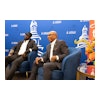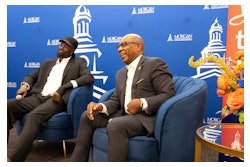HYATTSVILLE, Md. — In order to make the United States more globally competitive and secure from foreign attacks, the nation must radically transform the way it teaches foreign language.
That was the heart of the message that CIA Director Leon Panetta, U.S. Secretary of Education Arne Duncan and other government leaders delivered Wednesday to more than 300 foreign language educators who gathered at the CIA Foreign Language Summit at the University of Maryland University College conference center.
“If we are truly interested in having America succeed in the future, with regards to foreign language training, then I believe that the United States should require language study beginning at a younger age,” Panetta said, drawing applause.
“And, finally,” America’s top spy chief said, “we need to get back to mandating language training as a requirement for graduating from college.”
Although the conference focused heavily on how higher education can produce and cultivate the foreign language skills of America’s future spies and intelligence analysts, the panelists agreed that the best time to teach students a foreign language is long before they reach a college campus.
Panetta said K-12 educators need to focus on not just the three R’s of reading, writing and arithmetic but a fourth “R.”
“And that ‘R’ stands for reality, the reality of the world that we live in,” Panetta said. “This country cannot simply expect the rest of the world to speak English. We must be multilingual.”
“It is vital to our economic interests,” Panetta added. “It is vital to our diplomacy. It is vital to our national security to use the language of the people that we engage throughout the world.”
U.S. Secretary of Education Arne Duncan cited statistics that show foreign language instruction in the United States is generally on the decline and that universities are not producing enough foreign language instructors or students with degrees in a foreign language.
“Right now, too many colleges and universities are starting to scale back language programs or eliminate them altogether,” Duncan said. “And even those where the language programs remain intact, the priority is often put in the wrong place.”
Duncan lamented that 95 percent of college students enrolled in a language course to study a European language, but less than 1 percent of graduate students are studying a language that the Department of Defense views as critical for national security, such as Arabic or Pashtun.
“It’s clear to all of us that schools, colleges and universities need to invest more and invest smarter in language instruction,” Duncan said.
“So this is our challenge: To expand and improve language instruction at a time when financial resources are tight and the international economic competition is greater than ever.”
Duncan also stated that a priority for next year is to get the Elementary and Secondary Education Act reauthorized. He said ESEA, as envisaged by his administration, would include $265 million in competitive grants to strengthen teaching of the languages, arts and other things. Though many in education disdain the idea of competitive grants, Duncan urged summit attendees to accept the challenge to demonstrate the impact of second language programs.
He also lauded universities and colleges that get funding for foreign language instruction under Title VI of the Higher Education Act, particularly the 3 percent of America’s institutions of higher education that get funding through Title VI to teach “strategic languages” but account for half of all undergraduate enrollment and more than three-quarters of graduate enrollment in rare languages.
Dr. Clifford L. Stanley, Under Secretary of Defense for Personnel and Readiness, agreed but added that the effort to improve and expand foreign language instruction in the United States must begin at the pre-K level, not just in K-12.
Dr. Kira Gor, director of the Second Language Acquisition Program at the University of Maryland, said age 5 is generally seen as the “cutoff” age for being able to learn and speak a foreign language without being detected as a nonnative speaker.
“After that, you’ll be detected as a nonnative speaker,” Gor said. Students can still learn a foreign language later in their K-12 experience or as adults, but it becomes more of a labor-intensive process, she said, whereas learning a second language at an early age also increases a person’s mental capacity to pick up a third and fourth language later on in life.
Unfortunately, minority students are the least likely to get foreign language instruction in their pre-K or K-12 experience, laments summit attendee Gilbert W. Merkx, director of the Duke Center for International Studies at Duke University.
“Minority students tend to be in very poor school districts or come from backgrounds where learning a foreign language is not seen as an asset,” Merkx said. “And the poor school districts don’t have the money to hire foreign language teachers. It creates a vicious cycle.”
Dr. J. David Edwards, executive director of the National Council for Languages and International Studies, who also attended the CIA summit, said K-12 is further hindered from offering foreign language by the federal education law known as No Child Left Behind, which requires schools to get students proficient in certain areas, namely, reading, math and science.
“You have to be able to demonstrate Adequate Yearly Progress in certain areas,” Edwards said. “Foreign language is not one of those areas.”



















